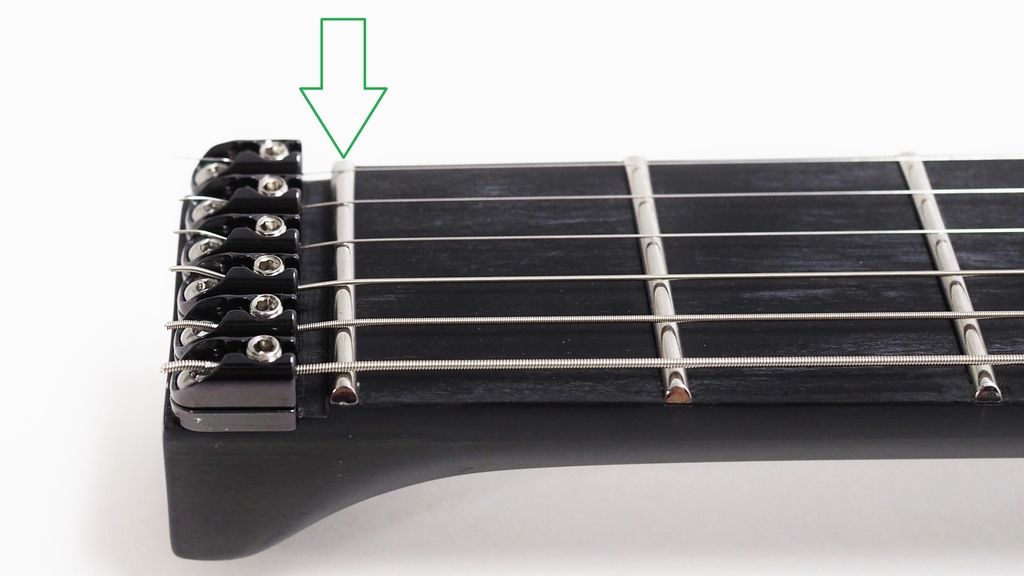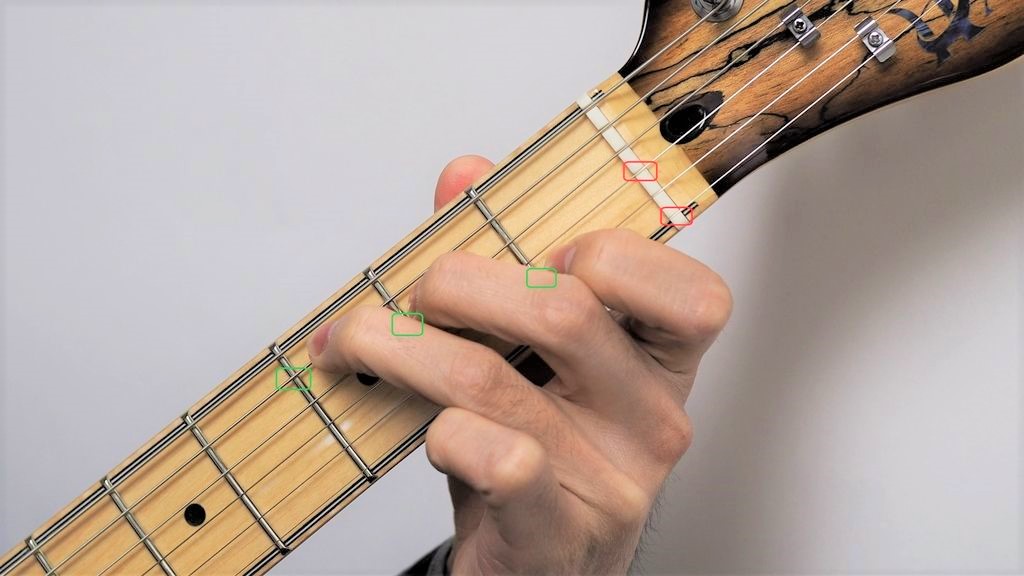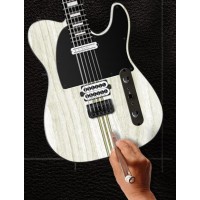We are now offering the option for a zero fret in addition to our regular nut options.
To help you decide whether a zero fret is right for you, I'll quickly discuss 3 things in this article:
- What is a zero fret?
- What are the benefits of a zero fret?
- What are the drawbacks of a zero fret?
WHAT IS A ZERO FRET?
For starters, a zero fret is a fret wire. This zero fret gets installed into the headstock-end of the fretboard... precisely where a regular nut would be installed.

The picture above shows a zero fret installed on one of our custom headless guitars. Notice there is no nut, only a zero fret.
The zero fret serves as the starting point of the vibrating length of the guitar strings (the ending point being the string saddles at the bridge). This means the guitar strings will be resting on the surface of the zero fret when the open strings are being played. This is not the case for guitars with regular nuts, as the strings would be resting on the surface of the nut in those cases.
WHAT ARE THE BENEFITS OF A ZERO FRET?
3 benefits for the player come to mind and they are:
- More consistent tone
- Better tuning experience
- Easier to set up
More Consistent Tone: the simplest way to understand how the tone can be more consistent is to consider what is happening when you play the guitar in any fret position except the open position. In every case, the string is pressed against the surface of a fret wire (e.g. if you play the 5th string on the 3rd fret, then the string is pressed against the surface of the 3rd fret wire), and that will necessarily affect the tone in some way (think metal on metal = a little brighter tone). Now, consider if you play a C chord:

You can see that some of the strings will contact the metal fret wire surfaces (circled in green), while other strings will contact the surface of the nut (circled in red), which might be plastic, bone, or something else other than metal. Whatever this other material is... it will necessarily affect the tone in some way that is different than the way a metal fret wire affects the tone. So, installing a zero fret in the place of that nut would result in a more consistent tone across the entire fretboard.
Better Tuning Experience: A good tuning experience is one that is responsive and inaudible. By responsive, I mean that the string increases (or decreases) in pitch the moment I turn the headstock tuner. By inaudible, I mean that the string doesn't make any pinging or creaking noises as I turn the headstock tuners. If there is a tremolo, then it is also good if the strings are able to return to pitch after using the tremolo.
Now, a bad tuning experience in those first two areas I mentioned can most often times be traced back to a poorly made nut. Specifically, if the string slots in the nut are not slotted in a way to which each string actually fits the particular slot that it sits in, then that string will not tune up responsively and it may make audible sounds like pings and creaks. When this happens, we basically just say "the string is binding in the nut" and the way we fix it is to widen the nut slot and maybe add some lubrication to the slot (e.g. graphite, big bends nut sauce, etc.) for good measure. So, bad nut slots = bad tuning experience, at least.
If there is a zero fret, however, then there are no slots at all! There's really no way for the string to bind at all - there is only the minimal amount of friction caused from the bottom of the string contacting the top surface of the fret, which is far less than the amount of friction created from the majority of a guitar string that gets sunken down into a too-narrow and too-deep nut slot! To make matters worse, if a string is binding in the nut, then it will be close to impossible for the guitar to return to pitch after using the tremolo in either direction (e.g. dive bombs or pull-ups). Zero frets offer a better tuning experience.
Easier to Set Up: Most guitars are delivered with 9's or 10's and standard EADGBE tuning. What if you wanted to throw on some 13's or 14's and play in Drop A? If there's a nut on your guitar, then you'll have to take a file to the nut slots to widen each slot, otherwise you'll experience the problems I mentioned in the paragraph above. What if during that process you accidentally slot the nut too deep? Now you have fret buzz and need to either fill the slot with some super glue and dust, or maybe even swap out the nut if you don't like fills. What if you don't want to play in Drop A anymore and want to go back up to E Standard? Well, now you've got some really skinny strings sitting is some really wide slots. Not the end of the world, but it might look odd to the detail-oriented, and it might even cause some slight buzz. The point is this: if you have a zero fret, then you can swap string gauges and not worry about the strings binding in the nut, or the action accidentally getting lowered to the point of causing buzz. Guitars with zero frets are easier to set up.
WHAT ARE THE DRAWBACKS OF A ZERO FRET?
One potential drawback is that the action for the open strings will be lower. This can be a bad thing for players who need to have higher action in the open position (e.g. players with heavier attack, or with floppier strings, both of which need higher action to avoid open string fret buzz). On the other hand, this lower action can be beneficial to players who don't have a heavy attack because it will be more comfortable to play and it will also improve intonation in the open position. Another potential drawback is the need for a "string guide" after the zero fret, which is usually a regular nut. The nut in this case serves only to keep the string spacing consistent. It does not affect string height whatsoever.
That's all for now! Feel free to leave comments or questions below. Thanks!
Your email address cannot be published. Required fields are marked*



hi , very good info. but i was thinking, is the zero fret a little bit taller then the other ones or it is the same height and you juste adjust relief with truss rod thanks ky-lam montreal canada
HALO ADMIN RESPONSE: We leave our zero fret a little taller than the rest, but I haven't personally experienced an issue with a zero fret that is the same height as the rest. - Jeff Lee, Halo
Would this work for a multiscale floating trem like the Sophia? Just a zero fret without a nut?
Hi Chris - yes, a zero fret can be used in conjunction with a multiscale guitar with a floating trem like the Sophia. Thanks - Jeff Lee, Halo Custom Guitars
hey, if i send you a telecaster, could you put a zero fret on it?
Hi David - we don't offer luthier services like this, but in theory, yes, something like that could be done (but not advised because the existing nut slot would have to be filled in order for the zero fret to be installed). Hope this helps! - Jeff Lee, Halo Custom Guitars